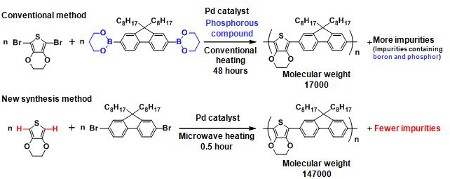New Synthesis Method of Materials for Organic Thin-Film Solar Cells Developed
Improvement of Power Conversion Efficiency through Purification
2014.02.11
(2014.04.01 Update)
University of Tsukuba
National Institute for Materials Science (NIMS)
New Energy and Industrial Technology Development Organization (NEDO)
A group of researchers led by Lecturer Junpei Kuwabara and Professor Takaki Kanbara of the Faculty of Pure and Applied Sciences, the University of Tsukuba, and Senior Researcher Takeshi Yasuda of the Photovoltaic Materials Unit, NIMS, and sponsored by the Industrial Technology Research Grant Program of NEDO, developed a new synthesis method of materials for organic thin-film solar cells and succeeded in obtaining high-purity materials in a simple and easy manner.
Abstract
A group of researchers led by Lecturer Junpei Kuwabara and Professor Takaki Kanbara of the Faculty of Pure and Applied Sciences, the University of Tsukuba, and Senior Researcher Takeshi Yasuda of the Photovoltaic Materials Unit, NIMS, and sponsored by the Industrial Technology Research Grant Program of NEDO, developed a new synthesis method of materials for organic thin-film solar cells and succeeded in obtaining high-purity materials in a simple and easy manner. They also discovered that high-purity materials synthesized by this new method can increase power conversion efficiency and extend the lifetime of organic thin-film solar cells. This discovery will become a guide in the pursuit of desirable methods of material synthesis toward achieving practical application of organic thin-film solar cells.
Conventionally, π-conjugated polymers, one of the materials constituting an organic thin-film solar cell, were synthesized mainly by way of a cross-coupling reaction. While this reaction makes it possible to synthesize diverse polymers, it uses compounds of tin, boron, phosphor and the like, and it is necessary to remove byproducts (impurities) derived from these compounds after the reaction. To solve this problem, the research group developed a new method of synthesizing π-conjugated polymers without using tin, boron, phosphorus, etc., by applying an efficient coupling reaction. This new method can completely eliminate the concern about residue (e.g. tin, boron, phosphorus, etc.) in the products and make it possible to simplify the purification process. This means that by this method, high-purity compounds can be obtained at a lower cost.
When the researchers fabricated solar cells using the polymer materials synthesized by the new method, they achieved 4% power conversion efficiency. Compared with the power conversion efficiency of 0.5% obtained from solar cells using polymer materials with the same frame synthesized by the conventional method, they found that the high purity of materials greatly contributed to improving power conversion efficiency . They also found that the use of high-purity materials can extend the lifetime of solar cells. This research shed light on the importance of the purity of materials in the course of improving power conversion efficiency of organic thin-film solar cells, and established a methodology for providing high-purity materials. The achievement in this research is expected to lead to the production of high-performance solar cell materials at a lower cost.
The research results was published in the online version of Advanced Functional Materials on February 10, 2014.

Formula 1: Comparison between the conventional method and the newly developed synthesis method. In the conventional method, it has been necessary to introduce boron (B), marked in blue, in the reactant, and to add a phosphorus compound (P) to the catalyst. There has been a concern that these substances could remain as impurities in the synthesized products. On the other hand, the new synthesis method does not need to use boron or other compounds because C-H coupling, marked in red, provides a reactive site. Thus, by using fewer additives, the quantity of impurities left in the polymer products can be reduced. The new method is also superior in terms of reaction efficiency, as it can obtain a polymer with a molecular weight of more than 140,000 in a shorter reaction time of 30 minutes.
